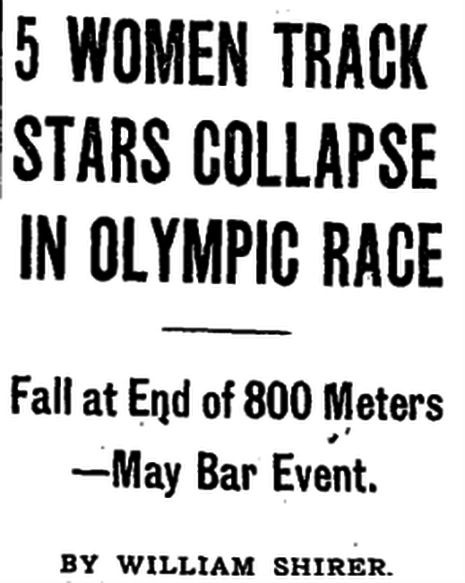Going the extra mile: the sexism of long distance running
Edward Cator takes a scrutinising scan of the gender discrimination still extant in women’s long distance athletics events.
To say that women have historically fought an uphill battle to gain athletic recognition is like saying that Caius College is a bit rich. Pierre de Coubertin, the organiser of the first modern Olympics in 1896, decided against allowing female athletes to compete because he felt that their inclusion would be “impractical, uninteresting, unaesthetic, and incorrect.” In 1900, women were generously allowed to enter the lawn tennis and golf competitions and, some 28 years later, the all-male International Olympic Committee saw fit to include female track and field events in the programme.

And so, 1928 saw the first Olympic women’s 800m race: Lina Radke of Germany topped a field of nine runners to take gold in a time of 2 minutes 16 seconds, followed by Kinue Hitomi of Japan and Inga Gentzel of Sweden. As may be expected of Olympic athletes after a race, several of the competitors were fatigued: some put their hands on their knees to recover, whilst German runner Elfriede Wever had tripped in the last hundred metres and suffered mild grazes. The newspapers went berserk.
The Chicago Tribune [left] reported that 5 of the women had collapsed at the end of the race, The Pittsburgh Press claimed that only 6 had actually completed the event, and The Times called the distance ‘dangerous’ for women. The Montreal Daily Star went one step further, calling the race a “disgrace” and recommending that it “should be taken off any future program” because, “it is obviously beyond women’s powers of endurance, and can only be injurious to them.” The fact that Radke had beaten the previous women’s world record by seven seconds did not feature in the media coverage of the event: nor was it provided as an explanation for the athletes’ tiredness. Of course, only feminine frailty could explain such visible exhaustion. The IOC were so appalled by this spectacle that they banned women from competing in events longer than 200m until 1960.
"The fact that Radke had beaten the previous women’s world record by seven seconds did not feature in the media coverage of the event: nor was it provided as an explanation for the athletes’ tiredness."
What a relief we live now in more enlightened times. True, by 1984 women’s events still made up just 25% of the Olympic programme and true, it took until 2012 for women’s boxing to finally be included. Yet, surely in the world of long-distance running, where household names such as Paula Radcliffe have done just as much to popularise the sport as Steve Ovett or Mo Farah, such thinly-veiled discrimination is a thing of the past. Perhaps not. A quick glance at the 2019 Nationals Cross Country Championships show that the undermining of female ability in distance races is still very much with us.
The climax of the day’s racing, the U20 event, involved runners aged 18-19, many of whom were coming to the peak of their athletic prowess. The distance for the U20 men’s race was set at 6.7km. The U20 women? 4.1km, the same distance that the U13 boys were expected to run. The idea that the finest female cross-country runners in the country are incapable of completing a park run is nothing short of absurd. Even on the elite international stage, the picture is no better: the women’s race at the 2019 World Junior Cross-Country Championships was a full 2 kilometres shorter than the men’s race.
"The U20 women? 4.1km, the same distance that the U13 boys were expected to run."
Maud Hodson, creator of #RunEqual, has claimed that women’s events are ‘downgraded’ in comparison to men. “Girls are conditioned from an early age not to aim high, not to challenge themselves,” she states, “and this is part of an insidious message that keeps girls and women in their place.” This distance discrimination seems even more unprincipled when one examines the trends in race results for ultra-marathons (running races longer than a standard 26.2-mile marathon). The statistics show that the longer the race the harder it is to separate the times of men and women: in races of 100 miles or more, a female runner is just as likely to get the fastest time as a male runner.
It was only in January last year that Jasmin Paris beat her closest male competitor by 15 hours and smashed the course record in the notorious 268-mile Spine Race, a non-stop run the length of the Pennine Way. Away from the world of running, in 2019 Sarah Thomas became the first human ever to swim the English Channel four times without stopping. Whilst it is true that in the shorter distances of cross-country women may not be as fast as men, the idea that female endurance is somehow second-rate is simply a fiction.
In a world where bigoted gender discrimination should be a thing of the past, in a country graced with such running talents as Laura Muir and Jessica Ennis-Hill, it seems ludicrous that the English Cross Country Association is still dwelling in the dark ages of pseudo-scientific sexism. The maintenance of segregated distances for male and female cross-country runners is nothing short of archaic. Surely it’s high time to consign Coubertin to the dustbin of history, and finally start treating athletes equally.
 Comment / Plastic pubs: the problem with Cambridge alehouses 5 January 2026
Comment / Plastic pubs: the problem with Cambridge alehouses 5 January 2026 News / SU stops offering student discounts8 January 2026
News / SU stops offering student discounts8 January 2026 Theatre / Camdram publicity needs aquickcamfab11 January 2026
Theatre / Camdram publicity needs aquickcamfab11 January 2026 News / News in Brief: Postgrad accom, prestigious prizes, and public support for policies11 January 2026
News / News in Brief: Postgrad accom, prestigious prizes, and public support for policies11 January 2026 News / Cambridge academic condemns US operation against Maduro as ‘clearly internationally unlawful’10 January 2026
News / Cambridge academic condemns US operation against Maduro as ‘clearly internationally unlawful’10 January 2026








